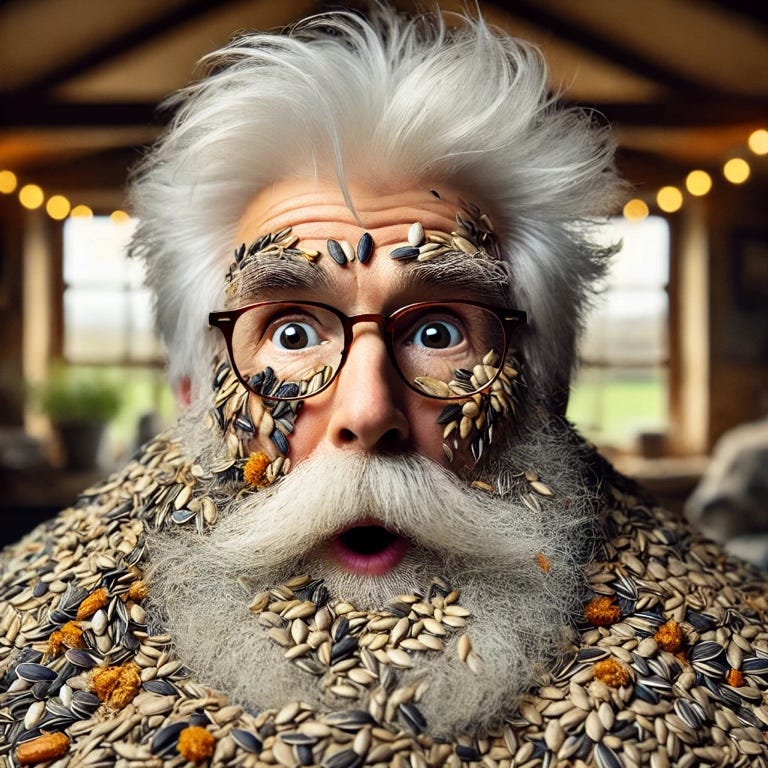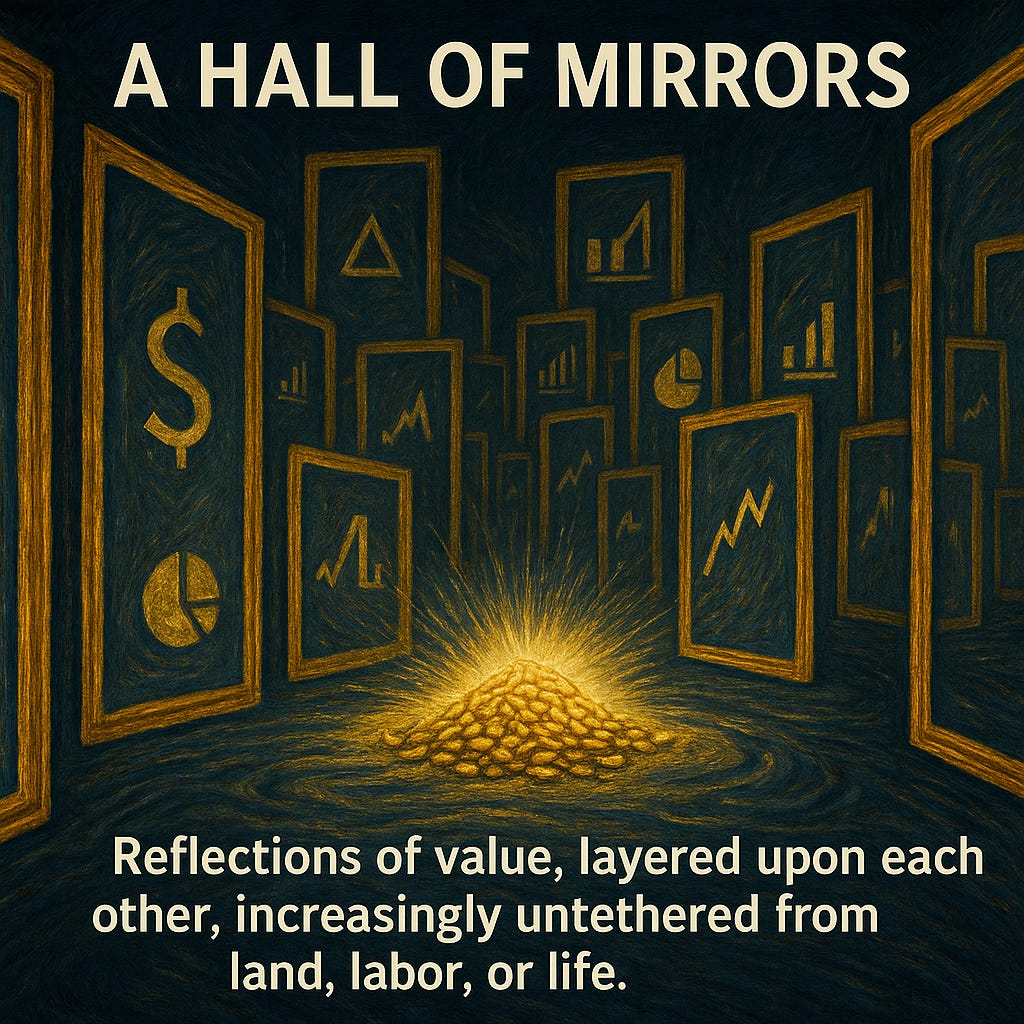The Seed and the Debt: A Tale of Two Value Systems
And One Value Certainty
Overview:
This article contains a number of personal reflections, I wanted to make this clear, initially, as you may wish to by-pass this altogether and I wanted to state this fairly as we commence.
And who is we, you might ask; (all) will be revealed should you wish to stay around.
Jocular though this image may look, we are deadly serious in this article.
Introduction: The Fog and the Kernel
In a world staggering under the weight of trillions in unpayable debt (many say that derivatives could have pushed this number into the quadrillions) and abstracted financial complexity, it is striking that the humble seed — a tiny, potent vessel of life — remains largely ignored in mainstream economic thought. While individuals are bound by strict rules of repayment and credit scores, and while institutions engineer invisible webs of risk through derivatives, the seed offers an alternative model of value: one rooted in reciprocity, regeneration, and abundance.
As a slight aside here, I have often been asked what my main investments are, (almost always meaning financial investments, my answer is two-fold:
Firstly I invest in myself, my knowledge, my health, etc.
Secondly, this is closely followed by seeds and has been so for the past 6 years. 5 years ago the collection was alphabetically organized packeted seeds in a large kitchen drawer. The image below shows the seed collection 1 year ago when we had 1,653 varieties. Currently, we have 2,136 varieties, that is varieties of seeds, not individual seeds.
I. What Are People Typically Investing In?
Here’s a categorized list of items people commonly invest in, each with a short description.
Traditional Financial Investments
Stocks: Ownership shares in a public or private company; value may rise with company performance.
Bonds: Debt instruments issued by governments or corporations; investors receive interest and principal back.
Mutual Funds: Pooled investment vehicles that spread risk across multiple stocks or bonds.
ETFs (Exchange-Traded Funds): Like mutual funds, but traded like stocks on an exchange.
Real Estate: Property investments, often valued for rental income or long-term appreciation.
Precious Metals: Gold, silver, platinum; valued for stability and scarcity, often used as inflation hedges.
Modern & Digital Investments
Cryptocurrencies: Decentralized digital currencies like Bitcoin or Ethereum; volatile but seen as alternatives to fiat systems.
NFTs (Non-Fungible Tokens): Unique digital assets, often artwork or collectibles, recorded on blockchains.
Tech Startups: High-risk equity investments in early-stage companies, often accessed through angel investing or crowdfunding.
Commodities & Derivatives
Futures Contracts: Agreements to buy/sell commodities at a future date for a set price (e.g., oil, wheat).
Options: Contracts giving the right (but not obligation) to buy or sell an asset at a certain price.
Forex: Trading of global currencies, typically in pursuit of small fluctuations in exchange rates.
Alternative & Tangible Assets
Art & Collectibles: Fine art, rare coins, stamps — valued for uniqueness and historical appreciation.
Wine & Whiskey: Some investors store rare bottles as long-term value-holding assets.
Timberland or Farmland: Long-term appreciation through land value, crop yield, or carbon credits.
Venture Capital / Private Equity: Investing in companies not listed on public markets, often with long lock-in periods.
Undervalued or Emerging Forms (Stressed - Emerging).
Seeds: Reproducible, regenerative, and decentralizable stores of biological value — rarely financialized.
Permaculture Systems: Designed ecological investments that yield food, soil health, and biodiversity over time.
Social Capital: Relationships and trust networks; intangible but critical for resilient communities.
Knowledge & Skills: Education, craftsmanship, and traditional wisdom as enduring forms of personal and collective wealth.
II. Debt: The Empire of Abstraction
Global financial systems thrive on abstractions. Derivatives, sovereign bonds, and interest rate swaps have grown so vast and intricate that not even regulators can agree on how much global debt truly exists — especially when derivatives are counted. This economy operates like a hall of mirrors: reflections of value, layered upon each other, increasingly untethered from land, labor, or life. As mentioned before, there are estimates that derivatives exposure (risk), raises our world debt levels into the quadrillions. One quadrillion as a number -
$1,000,000,000,000,000 (15 zeros).
Here is a good basic introduction to the convoluted world of derivatives.
Yet within this fog, individuals — the very foundation of societies — are held to rigid standards. Miss a payment, and your credit rating suffers. Default, and your home, your vehicle, your dignity may be seized. Meanwhile, the institutions that trade in risk are bailed out, backstopped, or simply too complex to fail.
This is not just financial imbalance. It is moral dissonance, as discussed in this article.
III. The Seed: A Value System of Life
Contrast this with the seed. A single lettuce seed, weighing less than a grain of sand, can produce a plant with thousands of seeds. It asks for no repayment — only care, time, and fertile ground. Unlike speculative assets, it does not require belief to function. It simply is. A biological algorithm passed through millennia, optimizing not for profit but for survival and reciprocity.
A seed cannot be short-sold. It cannot be infinitely leveraged. and its “derivatives” are more plants and more seeds. In addition, it can nourish a family. It can reclaim degraded land. It can bridge generations.
In the seed, we find a value system that rewards participation, not extraction. That teaches patience, not speed. That thrives in communities, not in silos.
IV. Why the Seed Is Ignored by the Market
If seeds are so potent, why aren’t they central to modern economies?
Because they resist commodification. Industrial systems can only profit from seeds by controlling them — through patents, hybridization, terminator genes, and legal restrictions. The free seed disrupts business models built on control. This is a great article on the behaviours of previously independent Monsanto.
Moreover, seeds follow rhythms. They are not bound to quarterly earnings but to seasonal cycles. They cannot be turned into speculative assets without losing their soul.
V. The False Scarcity of Debt vs. the True Abundance of Seeds
Debt systems are founded on scarcity — of money, of credit, of time. They operate by creating more obligations than can be fulfilled.
Seed systems are built on abundance — of biodiversity, of yield, of potential. A seed saved is not a liability; it is a promise. A decentralized store of value, a hibernated form of life..
Which system is more resilient?
Which one teaches us how to survive collapse?
Which one belongs in a world facing climate instability, food insecurity, and systemic fragility?
VI. Seeds as a Foundation for Regenerative Value
Seeds can form the basis of a new model of wealth:
Seed banks as real stores of value.
Seed exchanges as decentralized economies.
Seed saving as intergenerational wealth-building.
Seed literacy as resilience education.
Imagine communities where seed sovereignty underpins food security, where seeds are exchanged alongside stories, recipes, and cultural memory. Where value grows, quite literally, from the ground up.
Conclusion: Returning to What Is Real
We do not propose a utopia. Seeds are not magic. But they are real, and they are the beginning of everything. Seeds and spores have been around for over 400,000,000 (four hundred million) years!
While the debt-based economy spirals into ever more complex abstractions, seeds remain grounded. They ask nothing but offer everything. In the end, it may not be a derivative or a bailout that saves us — but a saved seed, planted by someone who remembered what truly mattered.
Thank you once again for reading this latest article of ours, we are creating a new fully valued system together. And who are we? Alexandra, Jeff, Luigi and myself and you can view what we have been doing for the past 11 years together, here.






